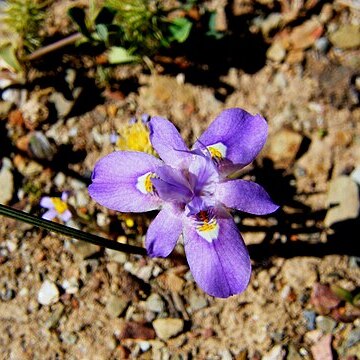Plants small, 50-180(-250) mm high. Corm 10-15 mm diam.; tunics of pale, netted fibres. Stems usually branched, either very short with nodes condensed, or elongated, sheathing leaves 25-35 mm long. Foliage leaves 1 or 2, linear, channelled, much longer than stem, 2-3 mm wide, margins straight; upper nodes with sheathing leaves ± as long as spathes. Rhipidial spathes membranous with prominent veins, becoming dry and transparent at flowering, inner 20-35(-40) mm long, outer slightly shorter. Flowers fugaceous, small, pale blue-mauve (rarely white), outer tepal limbs with white nectar guides edged orange distally, half reflexed; outer tepals 12-18 x 5-9 mm, claws as long or slightly shorter than limbs; inner tepals 12-16 mm long, limbs half reflexed. Filaments 3.5-6.0 mm long, united in lower 1/3-1/2; anthers 2.5-4.0 mm long. Ovary ± cylindric, included, 16-23 mm long, fertile part ± 6 mm long; style branches 4-7 mm long, diverging, crests 4-7 mm long, erect. Capsules ellipsoid, ± 10 mm long. Seeds dark brown, angular.
Perennial herb, geophyte, 0.05-0.20 m high; corm with pale tunics; stem usually branched, very short or elongate. Leaves 1 or 2, linear, canaliculate, 2-3 mm wide. Spathes usually dry, outer slightly shorter. Inflorescence with small flowers enclosed by translucent spathes; flowers pale mauve, occasionally white; nectar guides orange and white; tepals reflexed, outer 12-18 mm long, inner 12-16 mm long. Stamens: filaments united in lower 1/3-1/2, 3.5-6.0 mm long; anthers 2.5-4.0 mm long. Ovary with long tubular beak; style branches 4-7 mm long. Flowering time Sept.-Nov.
Cormous geophyte, 50-200 mm tall. Leaves 1 or 2, linear, channelled, trailing. Flowers enclosed by translucent spathes, small, pale mauve, tepals subequal, bearing orange and white nectar guides, tepals lightly reflexed.
Cormous geophyte, 5-20 cm. Leaves 1 or 2, linear, channelled and trailing. Flowers small, pale mauve, nectar guides orange and white, inner tepals reflexed.
A corm or bulb plant. It keeps growing from year to year. It grows 35 cm tall. The flowers are blue to purple.

